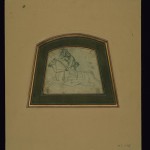Surfing through the glorious history of great and memorable Italian, French, German and American painters, the eastern painters hardly gets their name in an article or in any speech until it’s especially attributed to them. This negligence may have occurred because of the lack of interest and most notably the lack of the historical evidences to know more about them. Truth is, eastern artists are not as much as known or sought to be known even by the art-geeks in general. Many great names of them likely have forgotten or vanished from the history.
Though, thanks to some documentations and references, there are still some names remained to be remembered form the south Asia (mainly from India). Names like Govardhan, Bichitr, Abd-al-Samad, Miskin Kesu Das, Daswanth, etc. Majority of them were Hindu artists and their main patron was Akbar, the Mughal king of 16th century. Basavan was one of lead painters for whom the historiographer of Akbar said: “In designing and portrait painting and coloring and painting illusionistic…he became unrivalled in the world.”
Basavan, the name suggests that he was from the family of Ahir, a cow-herding Indian Tribe which still exists in modern times mostly in the reigns of Uttar-Pradesh and Saurashtra in Gujarat.
Akbar was the first king to create an art-studio in the realm. Thus, he gathered the artist all around India and commissioned them on different works. During the compilation of artists, Basavan also got selected for the Akbar-Durbar (Akbar’s court). There he came in contact with a Persian master painter of miniatures who had moved to India and later on became one of the founders of the Mughal Miniature. Under his instructions, Basavan’s artistic knowledge flourished. Due to this leaned expertise, he got to contribute in the Akbar’s most famous and important commission the Akbarnama, which literally means The Book of Akbar. It represented the story of Akbar from the start in visual manner. Pleased by his output, Akbar gave him other important commission like Razmnama (Persian Version of the India epic Mahabharata), Darabnama (Book of Darius), The Baheristan of Jami and Timurnama (Book of Timur).
The presented painting mentioned above was executed by Basavan for Akbarnama. It illustrates the court of young Akbar (age 13) commanding his first imperial order to arrest the unruly courtier. There are around 100 paintings executed by Basavan under the patronage of Akbar.
It is said that the works bought by Jesuit Missionaries from the western culture did a considerable impact on his work. The style of representation, color variations and the placements of the things has some similarities between Basavan’s and western art-works. Though, western style never gained major part in his art.
Based on very few resources, we still can know very much about Basavan’s great accomplishments in the art, which hints the importance he gained in his times.

 (1 votes, average: 4.00 out of 5)
(1 votes, average: 4.00 out of 5)
